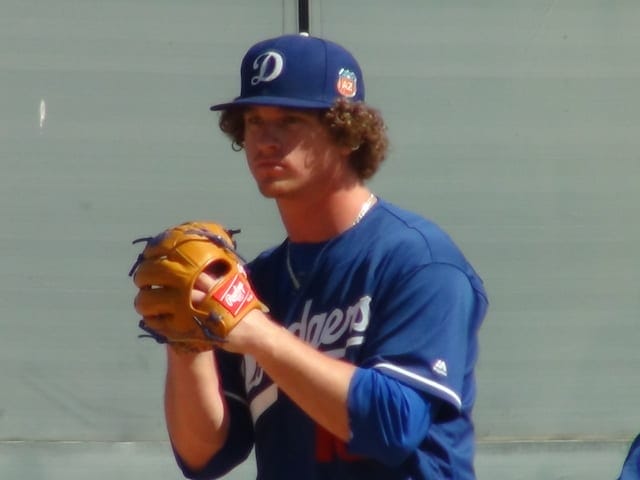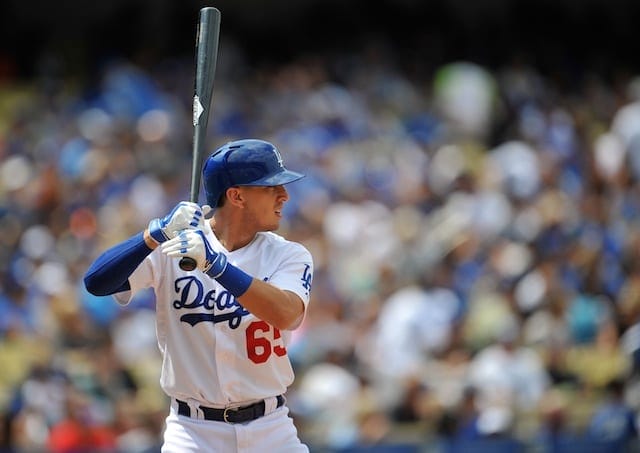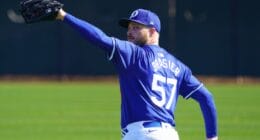
8. Yadier Alvarez, RHP
Rumors of the Dodgers blowing past their international spending limits during the current signing period seemed like an exaggeration, but ended up being an understatement.
According to Baseball America, the Dodgers have spent over $90 million in bonuses and tax penalties since July of last year, and that doesn’t include Kenta Maeda or Yaisel Sierra.
The biggest individual bonus went to Alvarez, who signed for $16 million on the first day of the period. The Cuban native looked like a Ramon Martinez clone in video, with a somewhat unconventional delivery and a long, lean frame.
However, during the spring, Dodgers development staff streamlined his mechanics and he throws more normally now. Still, the thing that stands out the most about the delivery is Alvarez’s complete and utter lack of effort.
During his first spring outing, Alvarez touched 99 mph and showed a promising slider. In his second, he sat around 93 mph, touching 97 and filling the strike zone. The slider showed flashes but he didn’t throw any that elicited oohs and aahs from the crowd.
It had nice shape but lacked the hard bite associated with a plus offering. He threw one or two changeups that caught hitters off guard and it profiles as at least an average pitch. Because Alvarez throws with such little effort and already displays three potential average or better pitches, it’s hard to know how high his ceiling is.
He just turned 20 years old in March, so there’s no rush to push him up the organizational ladder. Alvarez will likely hang behind in extended Spring Training before accepting a full season assignment in A-ball.
7. Grant Holmes, RHP
The Dodgers’ first round pick from 2014, Holmes pitched well in his debut in rookie ball before heading to Great Lakes the following year. Last season, he posted a 3.14 ERA in 24 starts with the Loons, striking out more than 10 batters per nine innings.
This year he’s joining the Quakes in the pitcher-unfriendly California League. At 6’1 and 215 pounds, Holmes was never a big projection guy.
His stuff has largely remained the same since high school. He starts with a fastball that sits in the 92-94 mph range and can get up to 96-97 mph when he needs it. He’ll sink it to induce groundballs and it features some arm-side run as well.
Holmes’ breaking ball has been a plus pitch for a few years now, featuring hard break and low 80s velocity. What sets him apart from most young arms is the fact that he already has an effective changeup and he’ll use it liberally against lefties.
Heading into 2016, Holmes only really needs to do two things — remain healthy and improve his command. He walked 4.7 batters per nine innings last year and ideally he’d like to reduce that by a third.
He also throws with a nice and easy motion and isn’t considered a major injury risk. Improving as a pitcher in the Cal League will be a big test for Holmes, who has the stuff and temperament to meet the challenge.
6. Alex Verdugo, OF
My podcast partner and acquaintance Dustin Nosler predicted the Dodgers would select Verdugo in the second round of the 2014 draft. However, few predicted that they would take him as an outfielder.
Verdugo had been up to 95 mph with a good breaking ball as a prep and many thought his future was on the mound. But the Arizona native wanted to hit and the club obliged, leading to a pair of very impressive seasons.
During his debut, Verdugo batted .353 between the Arizona League Dodgers and Ogden Raptors, walking 20 times compared to 18 strikeouts. So, it was a bit of a surprise when he opened last year in Great Lakes by hitting .243 in April and .191 in May.
It turned out that he adopted a leg kick to generate more power in his swing, but it threw his timing off and he abandoned it after two forgettable months. After that, Verdugo’s production would take off, as he batted over .350 the rest of the season, including .385 in 23 games with the Quakes.
Still only 19 years old, Verdugo shows advanced bat-to-ball and pitch recognition skills. He’s a high-contact hitter who uses the whole field. What’s more, in 2015, he hit .355 against lefties.
Verdugo is not a huge power prospect right now, but when he rotates his hips, he can put a charge in the ball and get it out of the park. He should develop at least average in game power as he progresses through the system.
In the outfield, he’s not a great runner but he’s adequate and gets good reads and jumps in center. His arm is an easy plus and would play well in right. He would obviously retain more value if he stays in center, but his body type and lack of plus speed may necessitate a move to a corner, where his average power may not play as well.
After his successful full-season debut, Verdugo was moved very aggressively to Double-A Tulsa to begin 2016. He won’t turn 20 until May and will be one of the youngest players in the Texas League.
Spending this season in Double-A and next year in Triple-A could set him up to take over left field with the Dodgers in 2018.
You can listen to Jared Massey on the weekly Dugout Blues Podcast.





